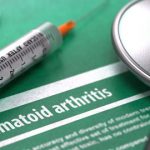WASHINGTON, D.C.—Increasing evidence suggesting that rheumatoid arthritis (RA) begins in mucosal sites such as the oral cavity and lung years before it appears in the joints may lead to improving treatment and prevention of the disease before it becomes symptomatic.
According to Kevin Deane, MD, a rheumatologist at the University of Colorado School of Medicine in Aurora, understanding that RA likely starts outside of the joints at the mucosal surface should lead to a paradigm shift in the way in which the etiology and pathogenesis of RA is investigated.
“We, as a rheumatology community, need to support research studies to improve our understanding of the process of generation of rheumatoid arthritis–related autoimmunity at mucosal sites so that we are able to reach the goal of preventing rheumatoid arthritis before the first swollen joint,” he said, “or even block the initial development of rheumatoid arthritis–related autoimmunity.”
Speaking here at the 2012 ACR/ARHP Annual Meeting, held November 9–14, Dr. Deane was one of a panel of experts describing recent evidence suggestive of this new paradigm shift in the session titled, “Extraarticular Involvement in Rheumatoid Arthritis.” [Editor’s Note: This session was recorded and is available via ACR SessionSelect at www.rheumatology.org.]
Although Dr. Deane focused on the lung as the primary site of generation of RA-related autoimmunity, Ted R. Mikuls, MD, MSPH, professor of internal medicine in the division of rheumatology at the University of Nebraska Medical Center in Omaha, focused on the oral cavity and periodontal disease as a risk factor for RA.
Does RA Start in the Lung?
Dr. Deane presented evidence to support the hypothesis that RA likely starts in the lung. “While many mucosal sites may be culprits,” he said, “much data support that the lung is the primary site of generation of rheumatoid arthritis–related autoimmunity for many subjects that develop rheumatoid arthritis.”
Among the evidence he presented supporting this hypothesis were data from a pilot study he and colleagues conducted that showed that persons at risk of RA based on their family history of disease had elevations of RA-related autoantibodies in their sputum but not in their blood.
According to Dr. Deane, these results indicate that these patients may be generating these autoantibodies in their lungs and support the notion that lungs are a site of initiation of RA-related autoimmunity for some people.
He emphasized that, if autoimmunity is generated in the lung, identifying mechanisms by which this autoimmunity develops such as pathways of tissue inflammation (e.g., formation of inflammatory tissue such as bronchus-associated lymphatic tissue), and identifying triggers for disease such as environmental factors (e.g., smoking) or organisms (e.g., Porphyromonas gingivalis) may lead to ways to prevent RA.
Periodontal Disease and RA
The role played by P. gingivalis was the focus of Dr. Mikuls’s presentation, in which he outlined evidence supporting an association between periodontal disease and RA. He said that the current data show that periodontal disease and RA coexist more than would be expected by chance alone, suggesting that periodontitis and poor oral health in general should be addressed to optimize overall health in patients.
Among the data he presented was a study he and colleagues recently published that looked at the relationship of P. gingivalis, the bacteria that causes periodontitis, to the presence of autoantibodies in individuals at risk of RA.1 The study found that the antibody to P. gingivalis was associated with the presence of RA-associated autoantibodies in people without RA but who are at increased risk of the developing the disease, said Dr. Mikuls. He said that this suggests that P. gingivalis could explain the associations reported to exist between oral health status and RA.
However, he emphasized that most studies to date looking at the association of periodontal disease and RA only have focused narrowly on the single organism of P. gingivalis and, therefore, could be missing the story. He pointed to a recent study by Scher et al that examined the diversity in the subgingival microbiome in patients with never-treated, new-onset RA.2 Along with finding that periodontal disease was much more common in these patients than in healthy controls, the study found that exposure to P. gingivalis was not unique to RA but did correlate with periodontal disease severity. The study also found that the role of other organisms Anaeroglobus geminatus and Prevotella/Lepotrichia species merited further study.
“Bacteria in the oral cavity coexist as a part of a very complex microbial community,” said Dr. Mikuls, adding that it may be that groups of bacteria or certain patterns of bacteria may be central to the associations between periodontal disease and RA other than simply P. gingivalis.
Although he said that the early evidence does suggest that periodontitis directly leads to autoimmunity or RA, he emphasized that further study is needed. If further evidence does indicate this association, he said that periodontal disease and related infections may then serve as a target for further therapies for RA, as well as disease prevention.
Mary Beth Nierengarten is a freelance medical journalist based in St. Paul, Minn.
References
- Mikuls TR, Thiele GM, Deane KD. Porphyromonas gingivalis and disease-related autoantibodies in individuals at increased risk of rheumatoid arthritis. Arthritis Rheum. 2012;64:3522-3530.
- Scher JU, Ubeda C, Equinda M, et al. Periodontal disease and the oral microbiota in new-onset rheumatoid arthritis. Arthritis Rheum. 2012;64:3083-3094.

